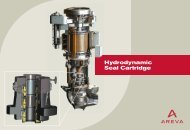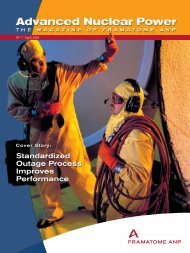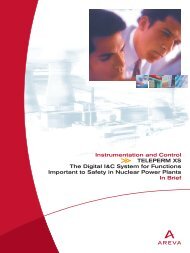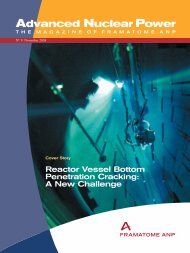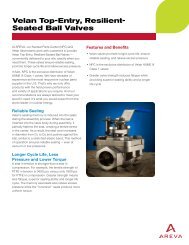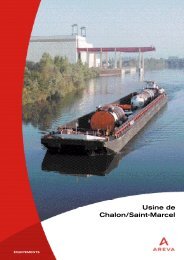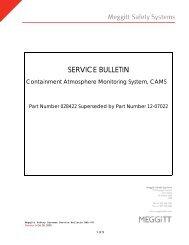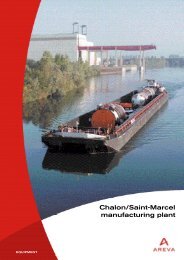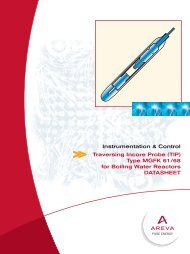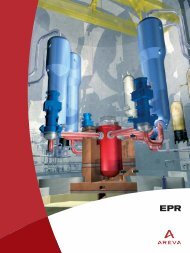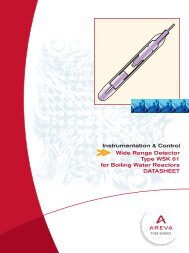Areva EPR
Areva EPR
Areva EPR
You also want an ePaper? Increase the reach of your titles
YUMPU automatically turns print PDFs into web optimized ePapers that Google loves.
Heavy reflector<br />
The heavy reflector is an innovative feature with significant<br />
benefits:<br />
† By reducing the flux of neutrons escaping from the core,<br />
the nuclear fuel is better utilized (more neutrons are<br />
available to take part in the chain reaction process),<br />
thereby making it possible to decrease the fuel cycle<br />
cost by reducing the fuel enrichment necessary to reach<br />
a given burnup, or to increase burnup with a given<br />
enrichment.<br />
† By reducing the neutron leakages from the core, the<br />
Reactor Pressure Vessel is protected against fast<br />
neutron fluence-induced aging and embrittlement,<br />
helping to ensure the 60-year design life of the <strong>EPR</strong>.<br />
† The reactor also provides advances in terms of<br />
mechanical behavior of the internal structure<br />
surrounding the core:<br />
• a smooth stress distribution inside the structure, due to<br />
an efficient inside cooling of the reflector, limiting loads<br />
and avoiding deformation,<br />
• no discontinuities, like welds or bolts, in the most<br />
irradiated areas,<br />
• a large decrease of depressurization loads to take into<br />
account in case of assumed loss of coolant accident,<br />
because there is no significant quantity of water<br />
trapped in the structure around the core.<br />
CHARACTERISTICS<br />
DATA<br />
Reactor pressure vessel<br />
Design pressure<br />
176 bar<br />
Design temperature 351 °C<br />
Life time (load factor 0.9)<br />
60 yrs<br />
Inside diameter (under cladding)<br />
4,885 mm<br />
Wall thickness (under cladding)<br />
250 mm<br />
Bottom wall thickness<br />
145 mm<br />
Height with closure head<br />
12,708 mm<br />
Base material 16 MND 5<br />
Cladding material Stainless steel (Cobalt 0.06%)<br />
Mass with closure head<br />
526 t<br />
End of life fluence level (E 1 MeV) IN-OUT<br />
fuel management scheme with UO 2 1 x 10 19 n/cm 2<br />
Base material final RT NDT<br />
(final ductile-brittle transition temperature) 30 °C<br />
Closure head<br />
Wall thickness<br />
230 mm<br />
Number of penetrations for:<br />
• Control rod mechanisms 89<br />
• Dome temperature measurement 1<br />
• Instrumentation 16<br />
• Coolant level measurement 4<br />
Base material 16 MND 5<br />
Cladding material Stainless steel (Cobalt 0.06%)<br />
Upper internals<br />
Upper support plate thickness<br />
350 mm<br />
Upper core plate thickness<br />
60 mm<br />
Main material Z3 CN 18–10/Z2 CN 19–10<br />
Lower internals<br />
Lower support plate thickness<br />
415 mm<br />
Lower internals parts material Z3 CN 18–10/Z2 CN 19–10<br />
Neutron heavy reflector<br />
Material Z2 CN 19–10<br />
Mass<br />
90 t<br />
† The design of the <strong>EPR</strong> reactor pressure<br />
vessel internals is based on the N4 and<br />
KONVOI proven designs.<br />
† The heavy neutron reflector brings<br />
an enhanced fuel utilization and protects<br />
the reactor pressure vessel against aging<br />
and embrittlement.<br />
† A low Cobalt residual content of the<br />
stainless steels is specified and the use<br />
of Stellite hard-facing is optimized so<br />
as to reduce radiation source term.<br />
I 25



